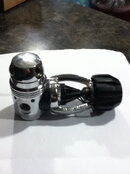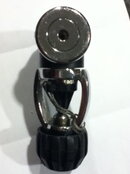Skinsfan0260
Registered
I was able to pick up a couple of used regulators for only fifty dollars. I wanted something that I could tear apart and take a look inside. Unfortunately when I put everything back together I now have leakage through the small ports in the regulator body. all the o-rings seam to be in great shape. I used the second regulator to ensure that I replaced everything on the first correctly back. I did have a friend clean them with her ultrasonic cleaner. They are now really shiny, really clean, but slowly leaking.
Regulator second stages says Waterlung by Sportsway. Sorry I do not have pics of second stages I am currently having my friend clean these also. They should be done by Monday. Does anyone know is the first stage is a Waterlung? I could not find anything on the internet that looked like this regulator that was made by Sportsway.
Regulator second stages says Waterlung by Sportsway. Sorry I do not have pics of second stages I am currently having my friend clean these also. They should be done by Monday. Does anyone know is the first stage is a Waterlung? I could not find anything on the internet that looked like this regulator that was made by Sportsway.






 That is my normal mode of reg repair, half the regs I restore with are not marked. Not many manuals around for 40-50 yo regs much less official parts but in general I agree with you. Restoring regs with no information and no parts is not to be taken lightly. The good news is, there is really only a couple of basic designs and once you understand them, DIY service manuals are not that difficult. I spend a lot of time studing the reg's design and measuring the parts I remove. I don't repair them for anyone else and mine never see a dive more challanging than 20 ft in the quarry. I just like to see if I can restore them.
That is my normal mode of reg repair, half the regs I restore with are not marked. Not many manuals around for 40-50 yo regs much less official parts but in general I agree with you. Restoring regs with no information and no parts is not to be taken lightly. The good news is, there is really only a couple of basic designs and once you understand them, DIY service manuals are not that difficult. I spend a lot of time studing the reg's design and measuring the parts I remove. I don't repair them for anyone else and mine never see a dive more challanging than 20 ft in the quarry. I just like to see if I can restore them. 